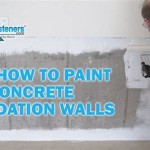How to Prepare Your Basement Floor Concrete Slab for Finishing
Finishing a basement floor can significantly increase a home's living space and value. The foundation for a successful finished basement lies in the preparation of the concrete slab. A poorly prepared slab can lead to issues like moisture problems, uneven flooring, and ultimately, a compromised finished space. This article outlines the essential steps involved in properly prepping a basement floor concrete slab for various flooring options.
Before commencing any work, it is crucial to understand the existing condition of the concrete slab. This assessment involves identifying any existing cracks, evaluating the levelness of the surface, and determining the presence of moisture. Addressing these issues proactively will ensure a durable and aesthetically pleasing finished floor.
1. Assessing and Repairing Existing Damage
The initial stage in prepping a basement floor is a thorough inspection for any signs of damage. Cracks are a common occurrence in concrete slabs, often resulting from settling, shrinkage, or excessive loads. These cracks, regardless of size, must be addressed to prevent further deterioration and potential moisture infiltration.
Hairline cracks, typically less than 1/8 inch wide, can often be filled with a concrete crack filler or epoxy specifically designed for concrete repair. Clean the crack thoroughly using a wire brush to remove any loose debris. Apply the crack filler, ensuring it penetrates the entire depth of the crack. Smooth the surface with a putty knife to create a flush finish.
Larger cracks, exceeding 1/8 inch, may require more extensive repair. These cracks often indicate more significant structural issues and may necessitate the use of a concrete patching compound. Before applying the patching compound, widen the crack slightly using a chisel and hammer to create a V-shaped groove. This allows for better adhesion of the patching material. Clean the groove thoroughly and dampen the concrete surface before applying the patching compound.
For significant structural cracks or heaving, it is advisable to consult with a structural engineer. These situations may require professional intervention to address underlying foundation problems before any cosmetic repairs are undertaken. Ignoring these issues can lead to recurring problems and structural instability.
In addition to cracks, look for signs of spalling, which is the chipping or flaking of the concrete surface. Spalling can be caused by freeze-thaw cycles, chemical exposure, or impact damage. Repair spalled areas using a concrete resurfacing compound. Clean the affected area thoroughly, removing any loose or crumbling concrete. Apply the resurfacing compound according to the manufacturer's instructions, ensuring it is properly bonded to the existing concrete.
2. Leveling and Smoothing the Concrete Slab
An uneven concrete slab can pose significant challenges when installing flooring. Even minor variations in level can result in uneven flooring, which can be both unsightly and potentially hazardous. Leveling the slab is a crucial step in ensuring a professional and durable finished floor. This process often involves the use of a self-leveling compound.
Before applying the self-leveling compound, meticulously clean the concrete surface. Remove any dirt, dust, grease, or debris that could interfere with the bonding of the compound. A thorough cleaning can be achieved using a concrete degreaser and a scrubbing brush, followed by rinsing with clean water. Allow the surface to dry completely before proceeding.
Prime the concrete surface with a concrete primer specifically designed for use with self-leveling compounds. The primer enhances the adhesion of the self-leveling compound and prevents moisture from being drawn out of the compound too quickly, which can lead to cracking. Apply the primer evenly using a roller or brush, following the manufacturer's instructions.
Mix the self-leveling compound according to the manufacturer's instructions. Use a mixing drill with a paddle attachment to ensure the compound is thoroughly mixed and free of lumps. Poorly mixed self-leveling compound can result in inconsistencies in the finished surface.
Pour the self-leveling compound onto the concrete slab, starting in the lowest area. Use a gauge rake or trowel to spread the compound evenly, ensuring it covers the entire surface. Work quickly, as self-leveling compounds have a limited working time. Allow the compound to cure completely according to the manufacturer's instructions before proceeding with flooring installation.
For minor imperfections and rough spots, a concrete grinder can be used to achieve a smoother surface. Use a diamond grinding wheel to remove any high spots or ridges. Wear appropriate safety gear, including a dust mask, eye protection, and hearing protection, when using a concrete grinder. Be meticulous when grinding the concrete, ensuring not to remove too much material and creating unevenness.
3. Addressing Moisture Issues
Basement floors are often susceptible to moisture intrusion due to their proximity to the ground. Excess moisture can damage flooring materials, promote mold growth, and create an unhealthy living environment. Identifying and addressing moisture issues is paramount before installing any flooring.
Conduct a moisture test to determine the moisture content of the concrete slab. Several methods can be used, including the calcium chloride test, the relative humidity test, and the plastic sheet test. The calcium chloride test involves placing a pre-weighed container of calcium chloride on the concrete surface and sealing it with a dome. After a specified period, the container is weighed again to determine the amount of moisture absorbed. The relative humidity test involves drilling small holes in the concrete and inserting probes to measure the humidity level. The plastic sheet test involves taping a plastic sheet to the concrete surface and observing for condensation after 24-48 hours.
If the moisture test indicates elevated moisture levels, it is crucial to identify the source of the moisture. Potential sources include groundwater intrusion, condensation, and leaks in plumbing or drainage systems. Addressing the source of the moisture is essential to prevent recurring problems.
Install a vapor barrier to prevent moisture from migrating through the concrete slab and into the flooring. A vapor barrier is a thin sheet of plastic material, typically polyethylene, that is placed directly on the concrete slab. Overlap the seams of the vapor barrier by at least 6 inches and tape them securely to prevent moisture from penetrating. Extend the vapor barrier up the walls several inches to prevent moisture from wicking up from the foundation.
Consider using a moisture-resistant underlayment beneath the flooring material. These underlayments are designed to provide an additional layer of protection against moisture and can help to prevent mold growth and damage to the flooring. Choose an underlayment that is specifically designed for use in basements and is compatible with the selected flooring material.
Ensure proper ventilation in the basement to help reduce humidity levels. Install a dehumidifier to remove excess moisture from the air. Consider installing exhaust fans in bathrooms and laundry rooms to vent moisture outside the house.
Choosing the appropriate flooring material is also essential when addressing moisture issues. Certain flooring materials, such as ceramic tile and vinyl, are more resistant to moisture than others, such as carpet and hardwood. When selecting flooring for a basement, prioritize moisture resistance.
In summary, preparing a basement floor concrete slab for finishing involves a meticulous process of assessing and repairing damage, leveling the surface, and addressing moisture issues. By following these steps, homeowners can ensure a durable, long-lasting, and comfortable finished basement space. Attention to detail and adherence to industry best practices are crucial for achieving optimal results.
Furthermore, remember to consult with professionals such as contractors and flooring specialists throughout the process. Their expertise can provide invaluable guidance and ensure that the project is completed successfully, within budget, and according to building codes. Engaging professionals can also mitigate potential risks and address unforeseen challenges that may arise during the preparation and installation phases.
Investing time and effort in properly preparing the concrete slab is an investment in the overall quality and longevity of the finished basement. A solid foundation will not only enhance the aesthetic appeal of the space but also protect it from moisture damage and other potential problems, ultimately increasing the value and usability of the home.

Insulating And Finishing An Old Basement Floor Fine Homebuilding

How To Stain Concrete Basement Floor Diy Guide

A Guide To Stained Concrete Basement Floors

Basement Concrete Floor Prep Pour Cabin Project

Do This Before Laying Carpet In Your Basement

Flooring Howto Convert Old Basement Slab Into Finished Concrete Floor Home Improvement Stack Exchange

Waterproof Basement Flooring What To Know About Waterproofing

8 Concrete Floor Makeover Success Tips From The Pros Brickform

Prep Work Done Before Pouring A Concrete Floor Vapor Barrier Wire Mesh Iso Strip Styrofoam

Do I Really Need A Concrete Basement Floor Greenbuildingadvisor
Related Posts







